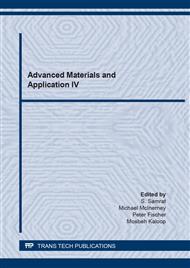p.3
p.9
p.17
p.23
p.47
p.53
p.61
p.69
Effect of Residual Aluminum Thickness on Microstructure and Strength of Friction Stir Spot Welded Aluminum Alloy/Copper Lap Joint
Abstract:
Dissimilar metal lap joining of A5052 aluminum alloy plate and C1100 pure copper plate was performed by using friction stir spot welding. The rotating welding tool, which was composed of a probe part and a shoulder part, was plunged from the aluminum alloy plate which was overlapped on the copper plate, and residual aluminum alloy thickness under the probe part of the welding tool after plunging of the welding tool was controlled in the range from 0 mm to 0.4 mm. The strength of the welding interface was evaluated by using tensile-shear test. Microstructure of the welding interface was examined by using an optical microscope and a field emission scanning electron microscope. The welding was achieved at the residual aluminum alloy thickness under the probe part of the welding tool below 0.3 mm. The welded area was formed at aluminum alloy/copper interface located under the probe part of the welding tool, and its width increased with decreasing the residual aluminum alloy thickness. A characteristic laminate structure was produced in the copper matrix near the welding interface. In the joint fabricated at the residual aluminum alloy thickness below 0.1 mm, hook of Cu was formed at edge of the welded area. The fracture did not occur at the welding interface. A remarkable improvement in strength was observed in the joint fabricated at the residual aluminum alloy thickness below 0.1 mm. The formation of laminate structure and hook is considered to result in joint strength improvement.
Info:
Periodical:
Pages:
3-8
Citation:
Online since:
August 2021
Authors:
Keywords:
Price:
Сopyright:
© 2021 Trans Tech Publications Ltd. All Rights Reserved
Share:
Citation:


